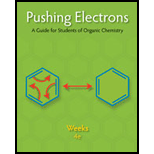
Concept explainers
Interpretation:
The leaving group in the given molecule is to be determined in order identify the positively charged and neutral fragments produced during mechanism.
Concept Introduction:
Heterolytic cleavage of sigma bond occurs under a variety of conditions. The mechanism of bond cleavage is as shown below,

The arrow in the above mechanism indicates that the sigma electrons form A-B bond are leaving A and becoming the exclusive property of B. Since the fragment A is formally losing one electron, it must become positively charged and B must become negatively charged since it gains an electron.
Often, heterolytic cleavage occurs from a charged intermediate that was formed in a previous step. The process is the same, but the charge on the products is different.

Want to see the full answer?
Check out a sample textbook solution
Chapter 3 Solutions
Pushing Electrons
- 7. The reaction of methoxide anion with bromoethane to yield the ether ethyl methyl ether and the bromide anon (Br-) is an excellent example of a general reaction type called Sy2 (substitution nucleophilic bimolecular): CH,0+ CH,СH-Br a CH3-0-CH,СH; + Br- a. Change in enthalpy is -103 kJ/mol; the change in entropy is + 0.025 kJ/mol-K. Calculate DG at 300K. b. Is the reaction endergonic or exergonic? c. Is the reaction endothermic or exothermic? d. Use curved arrows to show the complete mechanism. Reaction of 2-methyl-1-butene with H-Cl could yield TWO alkyl chloride products. Draw and name 8. them.arrow_forwardConsider this reaction: Br CH3OH Br-Br H3CO The mechanism proceeds through a first cationic intermediate, intermediate 1. Nucleophilic attack leads to intermediate 2, which goes on to form the final product. In cases that involve a negatively charged nucleophile, the attack of the nucleophile leads directly to the product. H. Br + CH;OH Br Intermediate 2 (product) Intermediate 1 In a similar fashion, draw intermediate 1 and intermediate 2 (final product) for the following reaction. OH + Br2 + HBr Br racemic mixturearrow_forwardA certain hydrocarbon had the molecular formula C18H30 and contained two triple bonds. Ozonolysis gave CH₂(CH₂)CO₂H and HO₂CCH₂CH₂CO₂H as the only products. Draw a reasonable structure for this hydrocarbon. Click and drag to start drawing a structure.arrow_forward
- Use the following reagent table for the reaction of : cyclohexanol + H2 SO4 → cyclohexene Chemical MW (g/mol) Density (g/mL) mmols used Amount used cyclohexanol 100.16 0.9624 1.50 mL Sulfuric Acid 98.08 1.83 1.0 mL cyclohexene 82.14 How many mmols of sulfuric acid are used? (answer with 2 decimal places, no units)arrow_forward4-pyranone will readily undergo an acid-base reaction. Identify the reaction conditions that will result in the formation of an aromatic product. Then, draw the aromatic resonance product structure. Include all lone pairs in your structure. Ignore inorganic byproducts. H3O+arrow_forwardIn the reaction given below, what type of reaction is used? n-Pentane → Isopentane нннн H ITH Н—С—с—С—с —О —Н Н—с—с— с-с—н ||| | H нн H Addition Elimination Substitution Rearrangementarrow_forward
- 6. (Chapter 15-Q37) Indole is an aromatic heterocyclic that has a benzene ring fused to a pyrrole ring. Answer the following questions. Indole 6(a) What is the hybridization of N in this molecule? = 6(b) How many pi electrons N contributes to the ring? = 6() Which orbitals contribute to form a sigma bond between N and H in this molecule? = 6(c) What is the electronic relationship of Indole to naphthalene? Give the answer by comparing number of rings and number of pi electrons in both compounds, write x rings, y pi electrons=|arrow_forwardDesribe the reaction product.arrow_forwardBased on the characteristics of the carbonyl group (C = O), what reactions or transformations take place with aldehydes and ketones? a. nucleophilic additions by oxygenb. electrophilic additions by carbon attackc. nucleophilic additions by carbon attackd. electrophilic substitutions through a carbocationand. acid-base because carbonyl can act as both an electrophile and a nucleophilearrow_forward
- 7. The following scheme shows the intermediates in the mechanism for the synthesis of isoamyl acetate, an ester with a characteristic banana flavor. Classify steps 1, 2, 3, and 4 as addition, elimination, substitution, or acid base reactions. lo ОН gor H2SO4 2 HO HO QH₂ H2SO4 1 .H ОН له عليه ملا 4 HO 3 لیڈ جل OH HO OH + H2O Harrow_forwardRadicals and carbocations are electrophiles. Define how and why ?arrow_forwardUse the following reagent table for the reaction of : cyclohexanol + H2 SO4 → cyclohexene Chemical MW (g/mol) Density (g/mL) mmols used Amount used cyclohexanol 100.16 0.9624 1.50 mL Sulfuric Acid 98.08 1.83 1.00 mL cyclohexene 82.14 Using the information from the previous questions, if 0.95 g of cyclohexene were formed during the reaction, determine the % yield. Answer with 2 decimal places.arrow_forward

